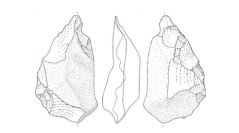

 Comptes Rendus Palevol
5 (1-2) - Pages 359-369
Comptes Rendus Palevol
5 (1-2) - Pages 359-369South Asia had a relatively stable climate during Lower and Middle Pleistocene; only the Himalaya piedmonts recorded periglacial conditions. The chronological setting of Palaeolithic assemblages is becoming more accurate in the last two decades as the dating methods improve and volcanic ash layers are identified in relation with sites. The first indication of human activity is recorded at around 2 Ma, in the northwestern sector of the Siwalik range, and the Acheulian starts before 1 Ma, in the Southwest of Indian Peninsula. It seems that Acheulian technological stage is not preceded by pebble/cobble tool industries, neither in the Peninsula, where such industries are unknown, nor in the Siwaliks, where they occur in abundance (Soanian technical tradition), but are probably later than the middle of Middle Pleistocene.
Asia, India, Siwaliks, Acheulian, Soanian, Early Palaeolithic, Pleistocene